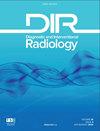基于二维和点剪切波弹性成像的测量对食管静脉曲张诊断的准确性:一项系统综述和荟萃分析。
IF 2.1
4区 医学
Q2 Medicine
引用次数: 4
摘要
目的:本meta分析的目的是总结点横波断层(pSWE)和二维(2D) SWE对食管静脉曲张(EV)和需要治疗的静脉曲张(VNT)的诊断准确性。方法:我们对诊断准确性研究进行了系统回顾和荟萃分析。我们使用PubMed center、SCOPUS、MEDLINE、Embase和Cochrane数据库检索了报道pSWE和2D SWE的EV和VNT诊断准确性的研究。采用STATA软件“Midas”软件包进行meta分析。结果共纳入24项研究,3867例患者。pSWE对EV的合并评分敏感性为91% (95% CI, 80%-96%),对VNT的合并评分敏感性为94% (95% CI, 86%-97%)。2D SWE的合并评分敏感性对于EV为78% (95% CI, 69%-85%),对于VNT为79% (95% CI, 72%-85%)。pSWE的EV合并评分特异性为70% (95% CI, 60%-78%), VNT合并评分特异性为59% (95% CI, 40%-75%)。2D SWE对EV的合并评分特异性为79% (95% CI, 72%-85%),对VNT的合并评分特异性为72% (95% CI, 66%-77%)。我们发现所有基于弹性学的测量结果具有显著的异质性,卡方检验结果和I2统计量为75%。结论pSWE和2D SWE均能诊断EV和VNT,诊断正确率中等。需要进一步的大规模特定环境的纵向研究来确定最佳模式。本文章由计算机程序翻译,如有差异,请以英文原文为准。
Accuracy of 2D and point shear wave elastography-based measurements for diagnosis of esophageal varices: a systematic review and meta-analysis.
PURPOSE The aim of this meta-analysis is to summarize the diagnostic accuracies of point shear wave elas- tography (pSWE) and two-dimensional (2D) SWE for esophageal varices (EV) and varices needing treatment (VNT). METHODS We conducted a systematic review and meta-analysis of diagnostic accuracy studies. We searched for studies reporting the EV and VNT diagnostic accuracy of pSWE and 2D SWE using PubMed Cen- tral, SCOPUS, MEDLINE, Embase, and Cochrane databases. STATA software"Midas"package was used for meta-analysis. RESULTS A total of 24 studies with 3867 patients were included in the review. Pooled score sensitivities of pSWE were 91% (95% CI, 80%-96%) for EV, and 94% (95% CI, 86%-97%) for VNT. Pooled score sensi- tivities of 2D SWE were 78% (95% CI, 69%-85%) for EV, and 79% (95% CI, 72%-85%) for VNT. Pooled score specificities of pSWE were 70% (95% CI, 60%-78%) for EV, and 59% (95% CI, 40%-75%) for VNT. Pooled score specificities of 2D SWE for EV were 79% (95% CI, 72%-85%) 72% (95% CI, 66%-77%) for VNT. We found significant heterogeneity for all the elastography-based measurements with the chi- square test results and an I2 statistic >75%. CONCLUSION Both pSWE and 2D SWE can diagnose EV and VNT with moderate diagnostic accuracy. Further large- scale setting-specific longitudinal studies are required to establish the best modality.
求助全文
通过发布文献求助,成功后即可免费获取论文全文。
去求助
来源期刊
CiteScore
3.50
自引率
4.80%
发文量
69
审稿时长
6-12 weeks
期刊介绍:
Diagnostic and Interventional Radiology (Diagn Interv Radiol) is the open access, online-only official publication of Turkish Society of Radiology. It is published bimonthly and the journal’s publication language is English.
The journal is a medium for original articles, reviews, pictorial essays, technical notes related to all fields of diagnostic and interventional radiology.

 求助内容:
求助内容: 应助结果提醒方式:
应助结果提醒方式:


